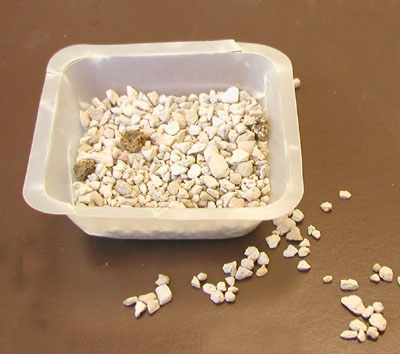Cat Litter

Most cat litter is made from clay (e.g., bentonite) that acts as an absorbent. Since clay typically contains elevated levels of naturally-occurring radionuclides, large amounts of cat litter can be measurably radioactive. Shipments of cat litter have been known to trip radiation monitors.
The photo to the right shows the collection's display of cat litter. Notice the cat litter on the outside of the "box" and the dried raisins inside. It won't be long before the raisins are also on the outside.
For fun, I measured the radionuclide activities in one sample of cat litter. The results were as follows: 4 picocuries per gram (pCi/g) for members of the uranium series, 3 pCi/g for members of the thorium series, and 8 pCi/g of potassium-40.
At these concentrations the exposure rate at six inches above a box of cat litter would be approximately 0.1 micro roentgen per hour (uR/hr) above background. Since cats don't spend a lot of time in the litter box (you never see them taking along something to read when they are heading that way), the radiation exposure is probably minimal.
I've seen varying estimates of the amount of cat litter sold in the U.S., but for the sake of the calculation, let’s assume 4 billion pounds per year. If true, this means that approximately 50,000 pounds of uranium and 120,000 pounds of thorium are purchased in the form of cat litter each year by the American consumer.
